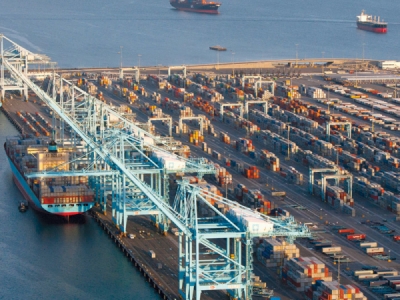
Posted on June 18, 2020
Container volumes in May were down at most of the nation’s major seaports as the facilities struggled with the deepening U.S. recession and the slowdown of Asian and European economies at the start of the coronavirus outbreak earlier this year.
Port of Los Angeles, the nation’s busiest, reported a 29.8% year-over-year decline in twenty-foot-equivalent (TEU) containers, moving 581,664 shipping receptacles compared with 828,662 in the same period of 2019.
At a news briefing on June 10, Eugene Seroka, the port’s executive director, cited the pandemic and a long-running trade dispute between the United States and China as the leading causes of the steep decline.
“It’s the slowest May since the Great Recession of 2009. There’s less consumer purchasing and less U.S. manufacturing,” Seroka said. “We also see the continued negative impact between the U.S. and China and the policies that have been in place.”

Seroka
Seroka is a longtime critic of the Trump administration’s tariffs on China, saying they hurt the U.S. economy.
Year-to-date, the Port of Los Angeles is running 18.4% behind 2019’s record rate.
Nearby Port of Long Beach processed 628,205 containers in May. That is a 9.5% increase compared to 2019’s 573,624 TEUs. While the number appears impressive in these economic times, an expert said there is a big asterisk with the monthly figures. Some 28.8% of the TEUs moved by longshoremen — totaling 181,060 — were empty containers that had been stored at Long Beach and nearby spots, taking up valuable real estate, and were shipped back to ports and other locations in Asia.
IHS Markit transportation economist Paul Bingham told Transport Topics the large number of empty containers being shipped back across the Pacific Ocean is another indication of how slow the economy was in March, April and May.
“You had containers that had been piling up here, and hadn’t been taken back,” he said. “When they’re empty, what do you do with them? You don’t have enough exports to fill them all. So the shippers brought in some larger vessels to haul away the empties.”
Still, port officials said they believe a turnaround is close.
“We aren’t out of the woods, but this is the gradual growth we have anticipated as the United States starts to rebound from the devastating economic impacts of COVID-19 and the trade war with China,” said Bonnie Lowenthal, president of the Long Beach Board of Harbor Commissioners.
Bingham said TEU counts are a leading indicator of the overall health of the economy. He believes the recovery will be slow, and the month of May was likely the low point.
“There’s not going to be a V-shaped recovery here, it’s not like in two months we’ll be back to where we were a year ago,” Bingham said. “At least in terms of the depth of how far off we are, it’s still going to be pretty bad, at least for the next couple of months.”
The Port of Oakland reported a 17% decrease in May, processing 184,995 TEUs compared with 223,095 in 2019.
“Since March, the port has seen indications of more significant cargo declines, so the May results are not unexpected,” said Port of Oakland acting Maritime Director Delphine Prevost. “Ocean carriers have been reducing the number of vessels in service in anticipation of expected declines in import demand.”
The Port of Virginia on June 15 reported the facility had a 22.7% decline in May, processing 112,913 containers compared with 146,018 last May.
“It is a significant loss in volume that is being felt throughout the organization, and the situation is similar across the entire maritime industry,” CEO John Reinhart said.
Georgia’s Port of Savannah reported a 9.65% decrease in container volume in May, which moved 337,360 TEUs compared with 373,394 in the same month a year ago.
Port Houston saw a 15.1% drop in TEUs to 222,250 compared with 263,061 in the same period a year ago.
Several ports, including the Port Authority of New York and New Jersey, the Northwest Seaport Alliance, which operates facilities in Seattle and Tacoma, Wash., and South Carolina’s Port of Charleston have not yet reported May results.
Source: ttnews





